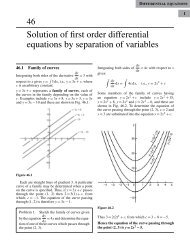vector
Create successful ePaper yourself
Turn your PDF publications into a flip-book with our unique Google optimized e-Paper software.
Vectors 395<br />
Example 30. Find the directional derivative of ( f) at the point (1, – 2, 1) in the direction<br />
of the normal to the surface xy 2 z = 3x + z 2 , where f = 2x 3 y 2 z 4 . (U.P., I Semester, Dec 2008)<br />
Solution. Here, we have<br />
f = 2x 3 y 2 z 4<br />
<br />
3 2 4<br />
f = i j k <br />
(2 x y z ) 2 2 4 3 4<br />
<br />
x y z<br />
= 3 2 3<br />
6 x y z i 4 xyz j 8x y z k<br />
<br />
<br />
<br />
2 2 4 3 4 3 2 3<br />
(f) = i j k (6x y z <br />
<br />
i 4x yz j 8 x y z k)<br />
x y z<br />
<br />
<br />
<br />
= 12xy 2 z 4 + 4x 3 z 4 + 24x 3 y 2 z 2<br />
Directional derivative of ( f )<br />
<br />
2 4 3 4 3 2 2<br />
= i j k (12xy z 4xz 24 x y z )<br />
x y z<br />
<br />
<br />
<br />
2 4 2 4 2 2 2<br />
= (12y z 12x z 72 x y z ) i (24xyz4<br />
48x3yz2)<br />
j<br />
+ (48xy 2 z 3 + 16x 3 z 3 + 48x 3 y 2 z) k<br />
Directional derivative at (1, – 2, 1) = (48 + 12 + 288) i + (– 48 – 96) j + (192 + 16 + 192) k <br />
= 348 i<br />
– 144 j 400k<br />
Normal to(xy 2 z – 3x – z 2 ) = (xy 2 z – 3x – z 2 )<br />
<br />
2 2<br />
= i j k <br />
( xy z –3 x – z )<br />
x y z<br />
<br />
<br />
<br />
2<br />
= 2<br />
( y z – 3) i (2 xyz) j ( xy – 2 z)<br />
k<br />
Normal at(1, – 2, 1) = i<br />
– 4 j 2k<br />
i –4j 2k<br />
Unit Normal Vector =<br />
= 1 ( – 4 2 )<br />
116<br />
4 21 i j k<br />
Directional derivative in the direction of normal<br />
1 <br />
= (348 i –144 j 400 k) ( i –4j 2 k)<br />
21<br />
1<br />
= (348 576 800) = 1724<br />
Ans.<br />
21<br />
21<br />
Example 31. If the directional derivative of = a x 2 y + b y 2 z + c z 2 x at the point<br />
x 1 y 3<br />
z<br />
(1, 1, 1) has maximum magnitude 15 in the direction parallel to the line ,<br />
2 2 1<br />
find the values of a, b and c. (U.P. I semester, Winter 2001)<br />
Solution. Given = a x 2 y + b y 2 z + c z 2 x<br />
<br />
= i j k <br />
x y z (a x2 y + b y 2 z + c z 2 x)<br />
=<br />
<br />
2 2 2<br />
i(2 axy cz ) jax ( 2 byz) kby ( 2 czx)<br />
<br />
at the point (1, 1, 1) = i(2 a c) j( a 2 b) kb ( 2 c)<br />
...(1)<br />
We know that the maximum value of the directional derivative is in the direction of . <br />
i.e. || = 15 (2a + c) 2 + (2b + a) 2 + (2c + b) 2 = (15) 2<br />
But, the directional derivative is given to be maximum parallel to the line










